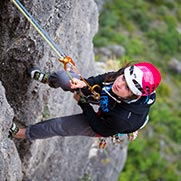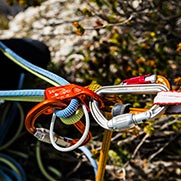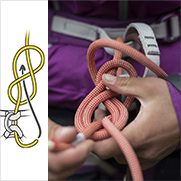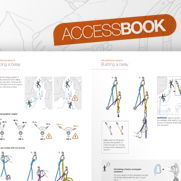Belaying the second with a MICRO TRAXION or NANO TRAXION: beware of any fall
MICRO TRAXION and NANO TRAXION are not belay devices. They were not designed or certified for this use. For practical reasons, however, they are sometimes used to belay a climber from the top anchor of a route. Petzl has conducted a series of tests to understand the limits and risks of this practice.
Warnings
- Carefully read the Instructions for Use used in this technical advice before consulting the advice itself. You must have already read and understood the information in the Instructions for Use to be able to understand this supplementary information.
- Mastering these techniques requires specific training. Work with a professional to confirm your ability to perform these techniques safely and independently before attempting them unsupervised.
- We provide examples of techniques related to your activity. There may be others that we do not describe here.
What makes it feasible to consider using a progress-capture pulley to belay a second, is that the rope above the climber can always be kept taut, thus preventing a free-fall.
For this, the belayer must be especially vigilant: they must take up rope as the climber progresses and avoid any slack between the anchor and the climber.
In particular, when nearing the anchor and during belay-station maneuvers, a 50 cm loop of slack can form very quickly, so all of the climber’s movements must be carefully monitored.
WARNING: using a progress-capture pulley to belay a second does not allow you to belay them effectively if they want to descend during the climb. It is recommended that the climber be informed of the use of this belay technique and that they know their own personal limits, so that they will also take appropriate precautions.
Certain situations can complicate the maneuver and increase risk:
- An overhang that the climber might not be able to pass: if the second is hanging on the rope, it becomes very complicated to safely lower them. The belayer should instead consider hauling to assist the climber in passing the overhang.
- A pitch that ends with a traverse: when the last quickdraw is unclipped, there is a risk of falling directly on the anchor. If the rope has been properly taken up as the climber progressed, it would mean a pendulum fall.
- Possible movements during belay-station maneuvers. WARNING: the climber absolutely must not climb to the level of the anchor and/or above the progress-capture pulley.
Tests conducted to better understand the risks of this use:
The fall tests were done with a flexible dummy (approximating the behavior of a human body). WARNING: these test results are provided for illustrative purposes only; many factors can worsen the results. In any case, it is recommended to avoid any falls.
Note: one total rope failure was observed during these tests, on a very worn rope (result in red). The results marked in orange represent failure of the rope’s sheath and one or more core strands, which is already an especially dangerous situation for the climber.
Measurement of the critical fall distance depending on the weight of the climber.
Fall factor 1 test, on new 9 mm VOLTA GUIDE rope.
Fall factor 1 comparison, on one strand of new 7.7 mm PASO half rope.
Comparison of results if a worn rope is used
WARNING: the behavior of worn ropes is not repeatable (depending on their level of wear and the type of wear); these results are given for illustrative purposes only (the tests were done with a well-worn rope).
The essential point to remember is that for this use, a worn rope must be used with even more vigilance than a new rope. (The opposite of a lowering situation where a new rope tends to be more slippery.)
Pendulum fall tests
When a pitch ends with a traverse, the risk of a pendulum fall cannot be avoided.
The tests were done for a fairly realistic case of a fall on 2 m of rope when the climber is 1.8 m from the anchor, at the same level.
Tests done on new rope only.









